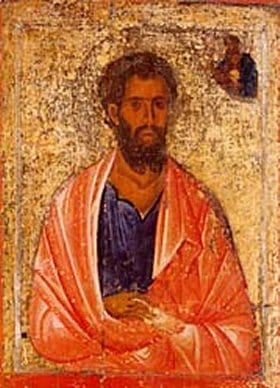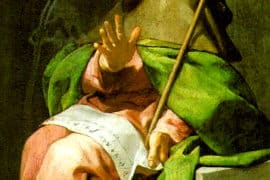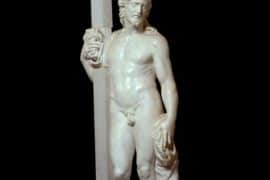Parts 1 & 2 are posted here and here. These were introduced by another post on “Another Comforter: The Forgotten Brother of Jesus” which you can read here.
The disciples said to Jesus, “We know you will leave us. Who is going to be our leader then?” Jesus said to them, “No matter where you go you are to go to James the Just, for whose sake heaven and earth came into being.”

James the Just One
The Gospel of Thomas was discovered in upper Egypt in 1945 outside the little village of Nag Hammadi. Although the text itself dates to the 3rd century, scholars have shown that it preserves, despite later theological embellishments, an original Aramaic document that comes to us from the early days of the Jerusalem church. See my post, “Discovering the Original Gospels of Thomas,” here, in which I highlight April DeConick’s commendable work. The Gospel of Thomas provides us a rare glimpse into what scholars have called “Jewish Christianity,” that is, the earliest followers of Jesus led by James the largely forgotten brother of Jesus. The Gospel of Thomas is not a narrative of the life of Jesus but rather a listing of 114
of his “sayings” or teachings. Saying 12 reads as follows:
The disciples said to Jesus, “We know you will leave us. Who is going to be our leader then?” Jesus said to them, “No matter where you go you are to go to James the Just, for whose sake heaven and earth came into being.”
Here we have an outright statement from Jesus himself that he is handing over the leadership and spiritual direction of his movement to his brother James! Jesus’ extravagant and unqualified statement reminds one of the honor that he paid to his kinsman John the Baptizer as “more than a prophet” and the greatest “among those born of women” of his generation in the Q source, the earliest collection of the sayings of Jesus now embedded in Luke and Matthew (see Luke 7:24-28). We should keep in mind that the Gospel of Thomas in its present form comes to us from a later period, when the matter of “who is going to be our leader” had become a critical one for the followers of Jesus. The phrase “no matter where you go” implies that the authority and leadership of James is not restricted to the Jerusalem Church or even to Roman Palestine. According to this text, James the brother of Jesus had been put in charge over all of Jesus’ followers. The phrase “for whose sake heaven and earth came into being” reflects a Jewish notion that the world exists and is sustained because of the extraordinary virtues of a handful of righteous or “just” individuals. James the brother of Jesus acquired the designation “James the Just” both to distinguish him from others of that name and to honor him for his preeminent position. The Gospel of Thomas provides us with our earliest and most clearly stated evidence that James succeeded Jesus as leader of the movement, though, as we have seen such a position is implied mutely in Acts 15. His succession is confirmed by many other sources outside the New Testament.
Clement of Alexandria, who wrote in the late 2nd century CE, is another early source who confirms this succession of James. At one point Clement wrote: “Peter and James and John after the Ascension of the Savior did not struggle for glory, because they had previously been given honor by the Savior, but chose James the Just as Overseer of Jerusalem (Eusebius, Church History 2.1.3). In a subsequent passage Clement elaborated: “After the resurrection the Lord [Jesus] gave the tradition of knowledge to James the Just and John and Peter, these gave it to the other Apostles, and the other Apostles to the Seventy” (Eusebius, Church History 2.1.4). This passage preserves for us the tiered structure of the provisional government that Jesus left behind: James the Just as successor; John and Peter as his left- and right-hand advisors; the rest of the Twelve; then then a larger body of “disciples,’ perhaps as many as 70, forming a kind of Nazarene “Sanhedrin.” This is precisely the kind of structure we find implied in Paul’s letter to the Galatians, combined with the more primitive materials embedded Luke-Acts (Luke 10:1-12; Acts 6:1-6).
Eusebius, the early-4th-century Christian historian, wrote in commenting on this passage, “James whom men of old had surnamed ‘Just’ for his excellence of virtue, is recorded to have been the first elected to the throne of the Oversight of the church in Jerusalem” (Church History 2.1.2). The Greek term thronos/θρονος, refers to a “seat” or “chair” of authority and is the same term used for a king or ruler.
Eusebius also preserves the testimony of Hegesippus, a Jewish Christian of the early 2nd century, whom Eusebius says is from the “generation after the Apostles”:
The succession of the church passed to James the brother of the Lord, together with the Apostles. He was called the “Just” by all men from the Lord’s time until ours, since many are called James, but he was holy from his mother’s womb (Church History 2.23-24)
The Greek word that Hegesippus used here, diadexomai/διαδεξομαι (“to succeed”), is regularly used for the passing on of a genetic inheritance, for example, when Philip king of Macedonia passes on his rule to Alexander the Great (see 3rd edition, BDAG Lexicon).
We also have a recently recovered Syriac source, The Ascents of James, that is embedded in a later corpus known as the Pseudo-Clementine Recognitions, that reflects some of the earliest traditions related to the Jerusalem church under the leadership of James the Just. [1]Robert E. Van Voorst, The Ascents of James: History and Theology of a Jewish Christian Community, SBL Dissertation Series 112 (Atlanta: Scholars Press, 1989) It records events in Jerusalem seven years following the death of Jesus, when James is clearly at the helm:
The church in Jerusalem that was established by our Lord was increasing in numbers being ruled uprightly and firmly by James who was made Overseer over it by our Lord” (Syriac Recognitions 1.43.3).
The Latin version of the Recognitions passed on the following admonition:
Wherefore observe the greatest caution, that you believe no teacher, unless he bring from Jerusalem the testimonial of James the Lord’s brother, or of whosoever may come after him” (4:35).
The Second Apocalypse of James, one of the texts found with the Gospel of Thomas at Nag Hammadi, stressed the intimate bond between Jesus and James, in keeping with the idea that he was the “beloved disciple.” In this text Jesus and James are said to have been “nursed with the same milk” and Jesus kisses his brother James and says to him, “Behold I shall reveal to you everything my beloved” (50.15–22). The Gospel of the Hebrews puts James at the Last Supper, thus implying he was one of the Twelve, and making it all the more likely that he is the “disciple whom Jesus loved,” see my recent post on this here. Although we don’t have the entire text, and it is preserved for us only in quotations by the 4th-century Christian writer Jerome, this gospel was originally written in Hebrew. Some scholars have maintained it might predate even our New Testament gospels.
What is impressive about these sources is the way in which they speak with a single voice, yet they come to us from various authors and time periods, with a variety of perspectives. The basic elements of the picture they preserve for us are amazingly consistent:
Jesus passes to James his successor rule of the Church; James is widely known, even by Josephus, an outsider, because of his reputation for righteousness both in his community and among the people; Peter, John, and the rest of the Twelve look to James as their leader.
Given what we now know we are in a position to investigate the type of Christianity that James the Just inherited from his brother Jesus and passed on, and what the existence of this Jesus dynasty reveals to us about the hidden and forgotten cause for which Jesus lived and died.
For a complete treatment of this subject, with full notes and sources, see my book, The Jesus Dynasty.








Comments are closed.